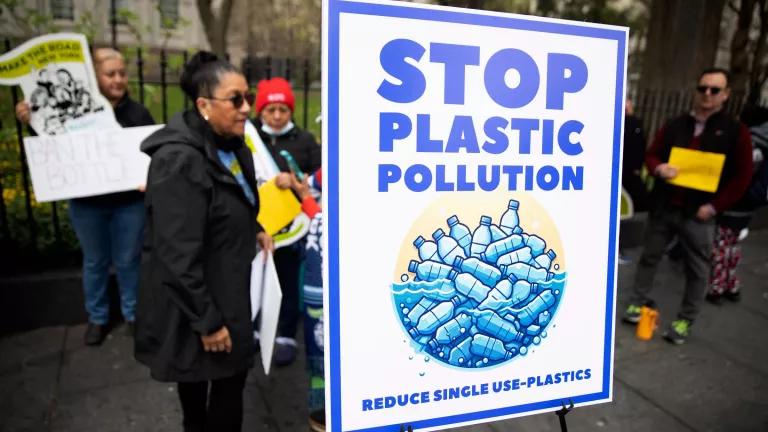
Mercury is a potent neurotoxin and a pollutant that knows no borders. Mercury pollution from halfway across the globe can end up in your local lake or the fish at your grocery store, where it poses a serious health hazard, especially for children and pregnant women.
Mercury moves around the world in three key ways. First, it is actively traded as a global commodity, often for uses like artisanal and small-scale gold mining (ASGM) in the developing world, where substantial mercury releases into the environment are routine. Second, airborne mercury, from burning coal for instance, can travel great distances before being deposited in waterways. Mercury released in Asia, for example, can circle the globe and enter American lakes and rivers. Third, once mercury enters a waterway, the natural bacteria can absorb it and convert it to a more toxic form: methyl mercury. Methyl mercury then enters the food chain through fish—and the fish we eat comes from all over the world. Stopping mercury pollution in the United States isn't enough to protect ourselves and future generations. Mercury pollution is a global problem that needs a global solution.
Mercury Poses Serious Health Hazards
The U.S. Environmental Protection Agency estimates that every year tens of thousands of American newborns are at risk of impaired motor skills and learning abilities as a result of their mothers' prenatal fish consumption. Emerging research also links mercury exposure to cardiovascular disease in adult men. Beyond these effects, scientists continue to raise flags about additional health threats posed by mercury exposure.
The Minamata Convention on Mercury
In 2009, the United Nations Environment Programme (UNEP) began a negotiating process that resulted in the Minamata Convention on Mercury. After four years of negotiations, the Minamata Convention on Mercury was adopted and opened for signature at a Diplomatic Conference (Conference of Plenipotentiaries), held in Kumamoto, Japan on October 10 and 11, 2013.
The Convention entered into force on August 16, 2017. The forms and guidance for complying with Convention obligations can be found at the Convention website.
Key Convention Obligations
Supply and trade controls:
- New mercury mines prohibited
- Existing mines to be phased out within 15 years
- Mercury from closing chlor-alkali plants cannot be sold or reused except within the chlor-alkali sector itself
- Mercury produced from mercury mines cannot be used for artisanal and small scale gold mining
- Importing country must consent to mercury trade
Product phase-outs:
- Batteries (except for two types of button cells often used in watches and hearing aids)
- Most switches and relays
- Skin-lightening soaps and creams
- Pesticides and biocides (including biocides in paints, but not vaccines), and topical antiseptics
- Measuring devices (barometers, hygrometers, manometers, thermometers, and blood pressure cuffs)
- Mercury content of most fluorescent lamps must be below specified levels
Process reductions:
- Mercury use in chlor-alkali production phased out
- Mercury use in the manufacture of PVC and polyurethane significantly reduced
- The use of mercury in artisanal and small scale gold mining reduced, and, where feasible, eliminated
Air emission controls required for new plants within five years and within 10 years for existing plants in the following source categories:
- Coal-fired power plants and industrial boilers
- Lead, zinc, copper, and industrial gold roasting and smelting processes
- Cement plants
- Waste incinerators
- Article: Emission-Limit-Oriented Strategy to Control Atmospheric Mercury Emissions in Coal-Fired Power Plants toward the Implementation of the Minamata Convention
- Article: Benefits of Regulating Hazardous Air Pollutants from Coal and Oil-Fired Utilities in the United States
- Article: Economic benefits of methyl mercury exposure control in Europe: Monetary value of neurotoxicity prevention
- Article: Mercury Exposure and Health Impacts among Individuals in the Artisanal and Small-Scale Gold Mining Community: A Comprehensive Review
- Abstract: Neurobehavioural Effects of Developmental Toxicity.
- Abstract: Historical Mercury Releases from Commercial Products: Global Environmental Implications
- Abstract: A global ocean inventory of anthropogenic mercury based on water column measurements
- Article: Adult women's blood mercury concentrations vary regionally in the United States: association with patterns of fish consumption
- Article: Future trends in environmental mercury concentrations: implications for prevention strategies
- Abstract: Implications of the Minamata Convention on Mercury for emissions from Asian coal-fired power generation
- Abstract: Recommendations for evaluating the effectiveness of the Minamata Convention on Mercury
Downloads



